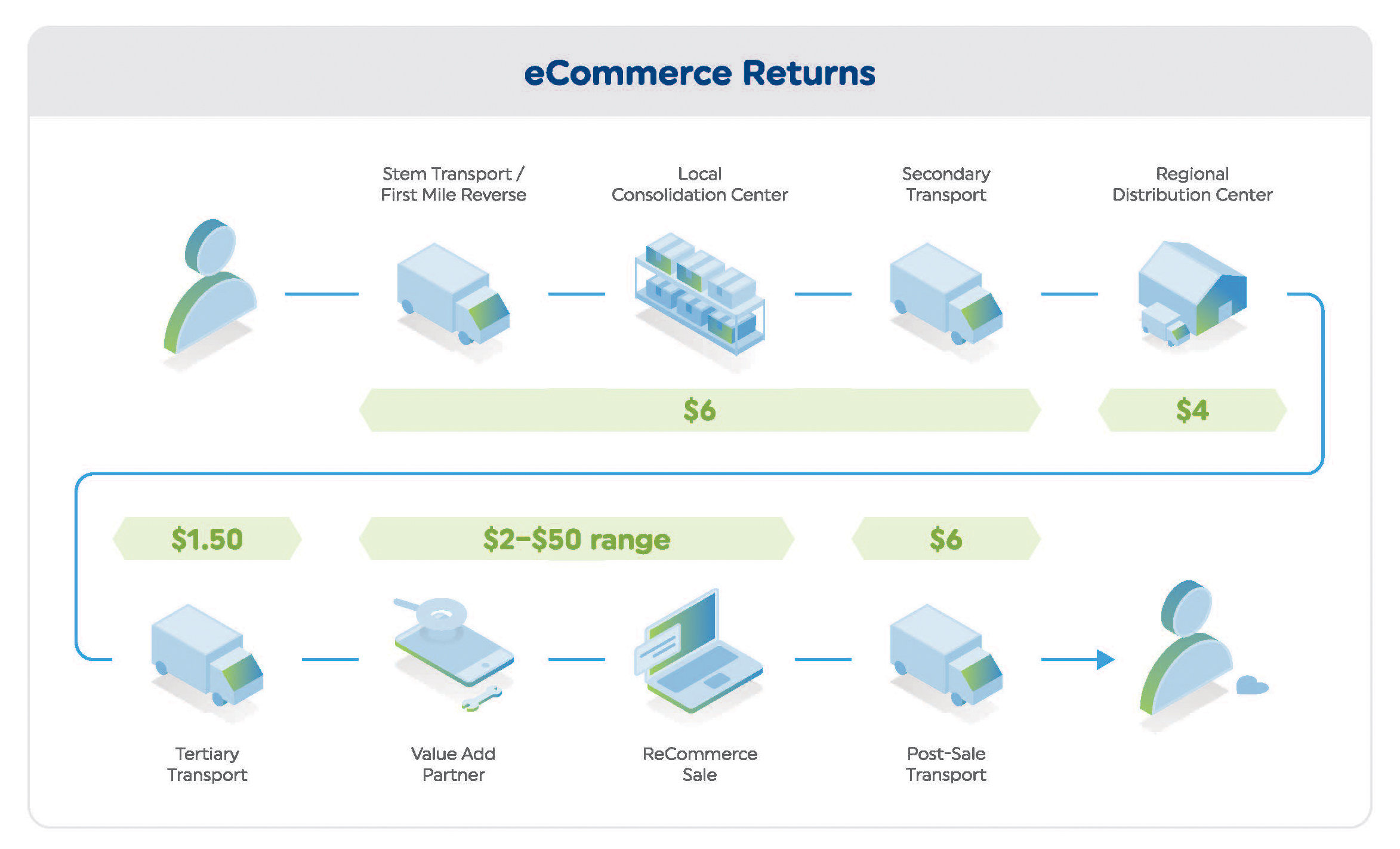Next Best Practices: Returns Management
By Fara Alexander, Chuck Johnston, ReturnPro
INTRODUCTION
For many years, retailers and manufacturers viewed returns as a “necessary evil” and committed limited resources to managing them. The systems they used to control and guide their reverse supply chains were limited in functionality. Most of the retail industry was established with policies and agreements that pushed the majority of product back to the manufacturer. What didn’t get sent back had limited alternative outlets, forcing many to dispose of perfectly saleable products. Over time, return policies were viewed as a key customer satisfaction component. The industry continued to enable favorable return terms to capture market share. As the big push into eCommerce arose, the industry again applied the same consumer-centric approach, propelled by Amazon’s lenient example, not realizing that it would generate 2-3 times the rate of return.
Over the past decade, the returns industry has grown from $264 billion (2012) to over $761 billion (2021), in large part because of eCommerce growth where return rates are over 20%. This added pressure the bottom line has been the catalyst of a paradigm shift across our industry. Retailers acknowledge the need to find more robust solutions and recognize that applying best practices to effectively manage Reverse Logistics not only mitigates financial loss, but can limit excess inventory, reduce waste, support key sustainability goals, and drive customer loyalty.
As retailers and manufacturers look to find solutions to this massive returns issue, there are a few core best practices that should be considered before allocating resources and investment to reverse supply chain activities. Developing these capabilities (or establishing partnerships with service providers who are experts in these areas) will create meaningful financial and performance driven results.
OPTIMIZE PROCESSING COSTS
Each year, it gets more expensive for retailers to process returns. Some key factors include rising transportation costs and labor costs, which saw a 42.1% and 16% increase respectively, in 2021. While retailers typically incorporate shipping costs into the retail price for each item, the added cost of the return is not always considered. As a result, retailers spend nearly twice as much to transport and touch returned products. In some cases, the cost to process a return can rise to nearly 70% of the cost of the item.
An eCommerce return is transported at least 4 times before reaching its final destination. This occurs because retailers often send items to multiple locations before devising the best disposition strategy. On average, returns transportation costs range from $10 - $15 per item. By having disposition capabilities integrated into their in-store or online POS, retailers can instantly route items to their value-add partners, instead of consolidating products at local or regional distribution hubs. In our experience, this optimized approach can reduce transportation spend by up to 50%.

DATA INTEGRITY – THE THREE C'S
Clean, consolidated, and current data is needed to access a full view of the overall health of reverse operations and dynamically update and store all information in a centralized repository. Managing these activities effectively requires a strong data foundation that can produce the right actionable insights at the right time.
One example of where the three C’s are critically important is when considering retailer and vendor agreements. The current state of policy management between most retailers and vendors is messy and prone to error. And that’s being kind. Most retailers and vendors manage policies through excel spreadsheets that are updated through human input, and consistently produce outputs with expired and outdated information. Not having a more dynamic way to manage contracts leaves the door open for dirty, disparate, and dated information that is extremely costly for both parties. We estimate that this issue costs the average fortune 1000 retailer $100+ million each year in overhead spend and uncaptured financial opportunities.
Whenever we onboard a new client, one of the first things we do is upload their existing vendor policies into our system. These policies provide a foundation for driving initial disposition decisions and help us efficiently manage RTV products to make sure that we fully-exploit RA allotments. We estimate that 20-30% of unclaimed RA credits are being left on the table because of the existing inefficiencies within the process. Often, retailers can’t even push disposition capabilities further upstream to reduce processing costs, because their agreements (merchant, vendor, accounting, legal, etc) live in disparate locations. Having a dedicated returns management portal, with one single source of truth keeps both sides accountable for meeting processing KPI’s, inspection requirements, shipping deadlines, and ensures retailers return only eligible products to the vendor (and capture their full benefit).
MAKE RETURNS A CROSS-PLATFORM PRIORITY
Retail returns don’t come with systemized naming conventions, neat packaging, or preset market values. Instead, they arrive in conditions ranging from brand new to beyond economic repair. Such inconsistencies require specialized management and necessitate an integrated, personalized approach to meet retailers’ and OEMs’ unique needs. Unfortunately, typical warehouse management systems (WMS) don’t function in a way to account for the complex variables of returns. Traditional enterprise warehouse systems excel at managing new inventory. They can carefully document stock levels, manage storage, move items around and organize transportation. However, they don’t provide a front-end experience, store-level actions, high-margin recovery decisions, or resale (reCommerce) assistance.
Enterprises that want reverse warehouse functionality must undergo a complicated, costly, and time-consuming process to merge various disparate platforms. In the end, these integrations can only work correctly if the platforms contain the most up-to-date contract and UPC data.
Custom Reverse Warehouse Management technology offers retailers the focused data and intelligence they need to maximize their returns. Reverse warehouse management systems like this integrate with retailers’ total returns software suite to guarantee their staff makes the best decisions at every touchpoint. As a result, retailers can cut processing time from several weeks to a few days while reducing resource requirements by 40%. These systems even go further by listing inventory directly on secondary marketplaces and fulfilling resale orders.
CONSOLIDATE EXTERNAL PARTNERSHIPS
In today’s retail landscape there are several niche players that provide siloed solutions for addressing aspects of the returns problem. Some companies provide customer-facing returns portals, others provide an outlet for portions of excess inventory or post-processed return goods. Most of these solutions are great in isolation, but outsourced returns management for different pieces of reverse supply chain creates choppy experience and prevents retailers from being able to link top line dollars and physical unit movement together. Having to contract with multiple businesses to solve this problem is complicated, requires additional oversight, more complex integrations, and often data is required to be passed between disparate systems with the potential of integrity issues.
What companies need is a single solution that can manage all these disparate elements, connect each step of the returns lifecycle, and direct products to channels that produce the best financial outcomes to help meet other key business objectives.

DELIGHT CUSTOMERS, BUT NOT AT THE EXPENSE OF BUSINESS
A current trend making headlines is the concept of product-less returns. On the surface this appears to be another customer-centric offering. While Amazon and Best Buy began offering the option years ago, returnless refunds have emerged as a popular way for retailers to ease their already-bloated inventory problems and keep processing costs down. If the retailer has a fully integrated returns solution and can determine that returning an item would cost more than the value that would be recovered, then it serves them and the customer not to require an item to be returned to issue credit. However, there are certain fraud and sustainability implications for retailers who don’t take a carefully managed and data-driven approach to administer this offering. Today’s fraud numbers are more than 10% and growing. To ensure that they are not being taken advantage of, they need a system that tracks abusive behavior and offers control to make disposition changes as needed. True end-to-end returns management systems must account for fraud risk and offer tools that users can integrate into their systems to prevent them from falling victim to retail scammers.
There are also concerns around sustainability and what consumers might choose to do if not held to the same accountability standard as retailers for these free, unwanted items. Fortunately, in a recent survey, over 80% of respondents told goTRG that they have either kept or donated items, instead of throwing them away.
CLOSING THOUGHTS
To date, most of the venture investment and emerging services surrounding returns have been focused creating a frictionless experience for the sake of maintaining loyal customers, without consideration of how or what happens to the items once a retailer receives them back. While these focused services do create marginal upside, a fully devised and implemented strategy that considers the customer journey from in-store or online returns initiation through to the resale of that item is the only way to create significant and sustaining value.
Optimizing processing costs, keeping clean data (and using it in the right ways), prioritizing returns across platforms, consolidating partnerships, and only offering returnless refunds when it benefits business all offer tremendous financial and environmental benefits. Our strengths in these areas have allowed us to maintain lasting relationships with some of the leading retailers and manufacturers. By implementing some of these best practices, retailers and their vendor partners will find themselves in a much stronger position to solve the $761 billion returns problem, especially as return rates and the associated processing costs will continue to soar into the holiday stretch.

 Fara Alexander, Chuck Johnston
Fara Alexander, Chuck JohnstonFara Alexander is the Director of Brand Marketing for goTRG, the leading returns management platform that offers turnkey software, reverse supply chain, and reCommerce services to retailers and manufacturers. Prior to joining goTRG, Fara was the founder and CEO of ReturnRunners, an on-demand consumer app that facilitated a seamless returns experience and streamlined returns consolidation on behalf of 80+ local and multichannel brands. ReturnRunners was selected as a finalist at the Future of Logistics Tech Conference in 2018 and was recognized as one of Chicago’s 50 startups to watch in 2019. Fara is an alumna of Chicago’s WiSTEM and UBS/Rent The Runway’s Project Entrepreneur accelerator programs. In 2022, Fara was recognized on Retail Touchpoints’ 40 Under 40 list. Chuck is currently the Chief Strategy Officer for goTRG, the leading returns management platform that offers turnkey software, reverse supply chain and reCommerce services to retailers and manufacturers. Prior to that he oversaw the development on operation of the return and repair operations for two of the largest retails in Home Depot and Walmart.
Chuck Johnston has been involved in the Reverse Logistics industry for over 20 years and is considered the foremost expert in the field. Chuck serves on the Advisory Boards for all three major Reverse Logistics consortiums. He is a sought-after speaker and considered one of the most innovative thinkers in the industry. In addition to his experience in the reverse space, he has led numerous Specialty Distribution Operations in his 30 years in Logistics. In his tenure at Walmart and Home Depot, Chuck was responsible for the development of a profitable, “best in class,” Reverse Logistics organizations that are the benchmark for all other retailers. In 2022, Chuck received a Lifetime Achievement Award from the Reverse Logistics Association for his contribution to advancing the reverse logistics industry.